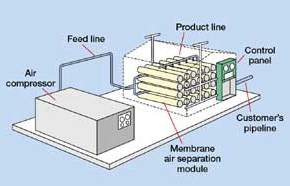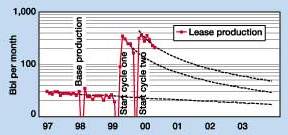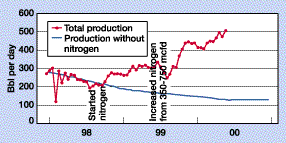Nitrogen huff and puff process breathes new life into old field
Nitrogen huff and puff process breathes new life into old fieldBernie Miller,* Bretagne G. P., Lexington, Ky., and
Robert Gaudin,** Nitrogen Oil Recovery Systems LLC, Evansville, Ind. Bottom line. Using a nitrogen huff and puff (cyclic) process, Bretagne G. P. increased production from a mature Appalachian basin reservoir from 200 bopd to 500 bopd with no significant increase in water production. Cumulative recovery through May 2000 is 115,000 bbl of oil from cumulative injection of 342 MMcf of nitrogen. The composite projected nitrogen utilization factor for the project is 1.2 Mcf per incremental bbl from the initial 163 wells treated. Huff and puff (cyclic) process. Conventional huff and puff applications have concentrated on using a solvent (such as steam or carbon dioxide). Applications often are limited by two factors – economic availability of the primary injectant and the mechanisms of the huff and puff process itself. This patent-pending huff and puff (cyclic) process using nitrogen addresses both concerns. Compact nitrogen membrane units (Fig. 1), currently used for onshore and offshore operations and in other industries, can provide nitrogen gas to oil fields at economical costs. From a displacement standpoint, this process also takes advantage of nitrogen’s unique characteristics, which allow natural gas to bypass and not be absorbed during the huff phase, and then to take the place of and displace oil and gas during the puff phase. The application is especially targeted for dual-porosity reservoirs where classic displacement mechanisms are non-commercial. From an operations standpoint, nitrogen is user-friendly in that it is inert, non-corrosive and environmentally friendly.
The huff and puff (cyclic) process is a single well process involving three basic phases:
If the process is performed at above fracture pressures or if the injectant reacts with the formation, then stimulation of the reservoir rock can take place. During the huff phase – since nitrogen does not dissolve in the reservoir fluids or dissipate, as is the case with carbon dioxide and steam – the gas is able to penetrate further into the reservoir. In the case of a fractured reservoir, the nitrogen can penetrate easier into the rock matrix. In the classic displacement process, the injectant goes into the matrix or fault blocks, but is trapped and cannot be easily produced. With depletion, the matrix has voidage that the nitrogen can occupy and then become trapped. Since nitrogen is a gas, the nitrogen occupies less space in the huff phase under higher pressure than in the puff phase, where the pressure has been significantly decreased. These basic processes, along with the relative permeability changes and gas trapping, can result in significant oil recovery. While in most cases additional oil recovery can be obtained by huff and puff with nitrogen gas, the efficiency of the recovery process is dependent upon the composite of reservoir characteristics and the procedure used. Big Andy project. Production from the Big Andy project in Lee County, Ky., is from a shallow (1,300-ft) reservoir with an average thickness of 40 ft. The reservoir is known to be a dual porosity or fractured reservoir system. Prior to the project, depletion from primary production had lowered the reservoir pressure to an average of 25 to 50 psi. Production from the 400-well project was only 200 bopd, averaging about 0.5 bopd/well. The low reservoir pressure and presence of natural fracturing facilitated gas injection during the huff phase. Nitrogen could be injected easily at 150 psi. At this design pressure, lower-cost polypipe line systems could be used to deliver the nitrogen to the wells. The initial nitrogen membrane unit was installed and started in July 1998 to deliver 350 Mcfd of 5% oxygen and 95% nitrogen. As experience was gained and the treating program expanded, volume was increased to 750 Mcfd within the next year. Nitrogen purity, targeted at 95%, can range from 93 to 95%. Adverse effects of lower purity (higher oxygen) nitrogen vary, depending upon the sensitivity of brine and other constituents to higher oxygen levels. Nitrogen is injected down the annulus of producing wells. Individual well injection rates vary from 20 to 100 Mcfd, depending upon the stage of injection in the well and the relative permeability to gas, with the average rate during injection being about 50 Mcfd per well. At these rates, about 15 wells are in the huff phase at any one point in time. To date, most producers are in the first cycle. The typical initial cycle consists of injecting about 1.0 MMcf of nitrogen, a shut-in period of about 30 days, and then the well is returned to production. Cycle interval depends upon many factors. The overriding consideration is that recovery per cycle will overlap; thus, oil recovery is not believed lost by retreating prior to production returning to the base line. Thus, the interval is dependent upon the optimization of the resources available, including, but not limited to:
Production response to two cycles on the Noah Little lease is illustrated in Fig. 2. The first cycle used 860 Mcf per well, and has a projected incremental recovery of 1.7 Mcf per incremental bbl over base production. The second cycle used 570 Mcf per well and has a projected recovery of 1.4 Mcf per incremental bbl over first-cycle projected production.
Through May 2000, oil production has increased from 200 bopd with a 40% decline rate to 500 bopd, and it is still increasing, Fig. 3. With the increase in gas production, part of the casing head gas is being gathered and compressed for use as fuel, stripped of liquids and recycled. Further gas processing is being evaluated on a stand-alone basis. Expectations are that overall recovery may be increased 10 to 20% by recovering the liquids in the produced gas.
Cumulative incremental oil recovery through May 2000 is 115,000 bbl from cumulative nitrogen injection of 342 MMcf – or a nitrogen utilization of about 3 Mcf per incremental bbl. Injection volume includes gas injected into wells currently shut in during injection and in the shut-in period. Cumulative incremental oil does not include future production from the gas that has been injected. Estimated ultimate nitrogen utilization factor on the first 163 wells is 1.2 Mcf per incremental bbl, ranging from 0.5 to 2.0 Mcf per incremental bbl for individual leases. Economic data. Nitrogen (95% purity) can be generated using a nitrogen membrane unit for approximately $1.50/Mcf, depending upon cost of electricity, unit size, cost of capital and maintenance cost. Well treatment cost depends upon availability of nitrogen transportation to the wells and the cost of well preparation. In the Big Andy case, a pre-existing oil sales line is being used to distribute nitrogen through the field to the central tank batteries, and the flowlines are reversed during the huff treatment on a lease basis. The wells are prepared by shutting down the pumping units, and nitrogen is diverted into the casing annulus. Under this system, the composite cost of the nitrogen is about $2.00 per Mcf. Average payout time is 150 days at current oil price ($25/bbl), including well shut-in time for injection and shut-in. With no increase in water production and no increase in other operating costs, the incremental production goes to the bottom line. Of particular significance, the process can be tested in a given reservoir without a great deal of capital exposure. Acknowledgment Case study material has been presented to a local section meeting of SPE in Paintsville, Ky., during February 2000 and an Independent Oil & Gas Association Meeting of New York in June 2000.
|
|||||||||||||||||||
- Applying ultra-deep LWD resistivity technology successfully in a SAGD operation (May 2019)
- Adoption of wireless intelligent completions advances (May 2019)
- Majors double down as takeaway crunch eases (April 2019)
- What’s new in well logging and formation evaluation (April 2019)
- Qualification of a 20,000-psi subsea BOP: A collaborative approach (February 2019)
- ConocoPhillips’ Greg Leveille sees rapid trajectory of technical advancement continuing (February 2019)





